While visiting Al-Maghtas, Baptism Site “Bethany Beyond the Jordan” with a group of Jordanians, we got to the place that is believed to be exactly the place where Saint John the Baptist baptised Jesus Christ. In other words, Christianity started right here.
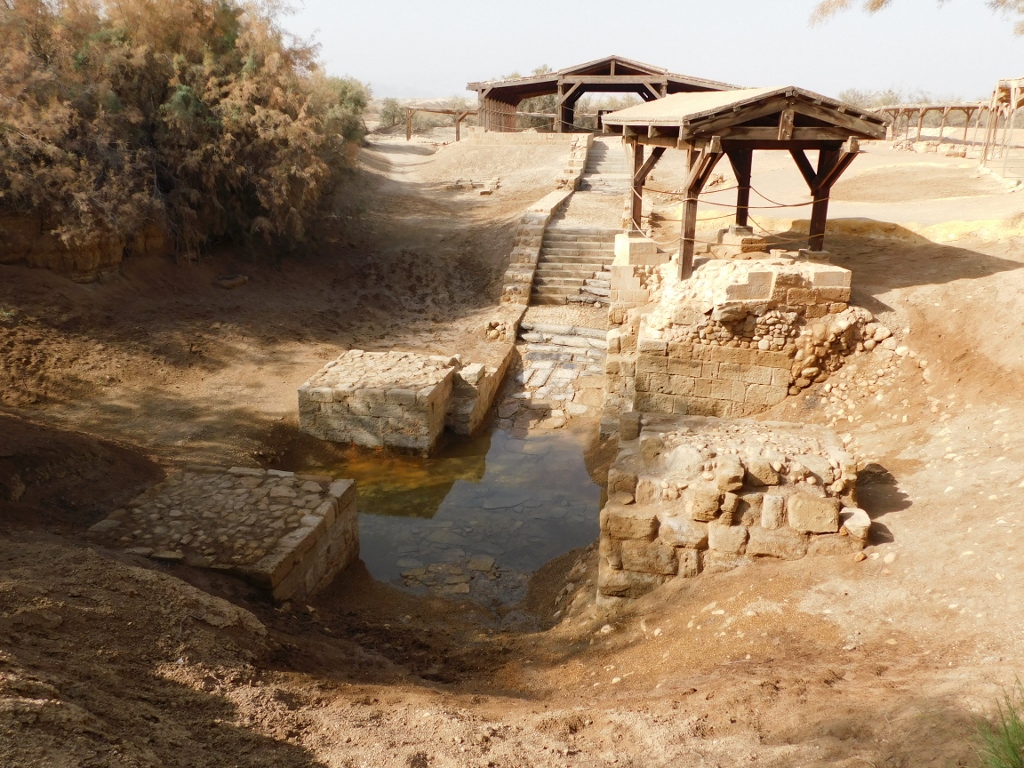 Judging by all, Jesus Christ was baptised here
Judging by all, Jesus Christ was baptised here
In the previous sequel of my travel stories I mentioned that Saint John probably used the water from the clear streams for the symbolic cleansing of the sins of the people who came to him and, as the guide told us, according to the tradition, John baptised people in three venues in this area, but he baptised Jesus directly in the Jordan river. The water that can be seen in this spot today is in fact a part of the ground water and it is believed that the Jordan river actually moved because nowadays it flows along a different bed that is a few hundred metres farther away.
What is insisted upon here is that the Bible says that Jesus was baptised in “Bethany Beyond the Jordan.” Since the main events mentioned in the Bible that were linked to the life of Jesus took place west of the Jordan river, saying “beyond the Jordan” clearly indicates that the baptism took place on the east side of the river, i.e., on the territory of the present-day kingdom of Jordan.
The covered area that is seen in the background in the photo above and the photo below was discovered in 1999 and at that time archaeologists excavated five churches that were built one on top of the other in the period from the 5th to the 12th century. These remains fully correspond to the descriptions provided by pilgrims who used to come here at the time. Bearing in mind that there was no permanent settlement here, in other words, there was no real need for this many churches as there were no permanent worshippers, this clearly indicated the significance of this place and thus the archaeologists continued with the excavations, discovering also the baptismal pool along the way.
The records of the pilgrims, for instance those from the 6th century, also mention marble stairs that were used in order to go down into the water and this is precisely what can be seen here today.
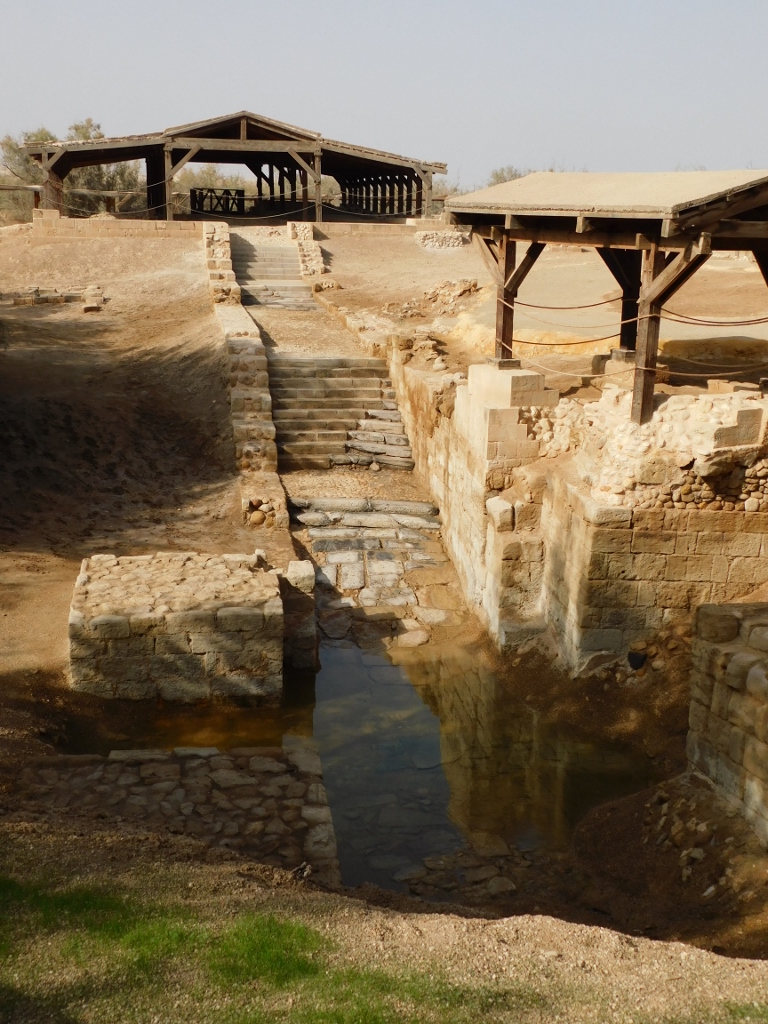 Baptism Site “Bethany Beyond the Jordan,” remains of the churches in the background and the marble stairway
Baptism Site “Bethany Beyond the Jordan,” remains of the churches in the background and the marble stairway
In 670 CE, another pilgrim wrote that a small, square-base church was built right on the spot where Jesus had put his garments while he was being baptised. The chapel was duly named the Mantle Chapel. This same record states that the church was built on top of four stone arches underneath which ran the water. This was mostly done in this way in order to protect the church against the Jordan’s floods that were frequent. Nowadays, one can clearly see the cruciform plan of the baptismal pool reached by the marble stairway.
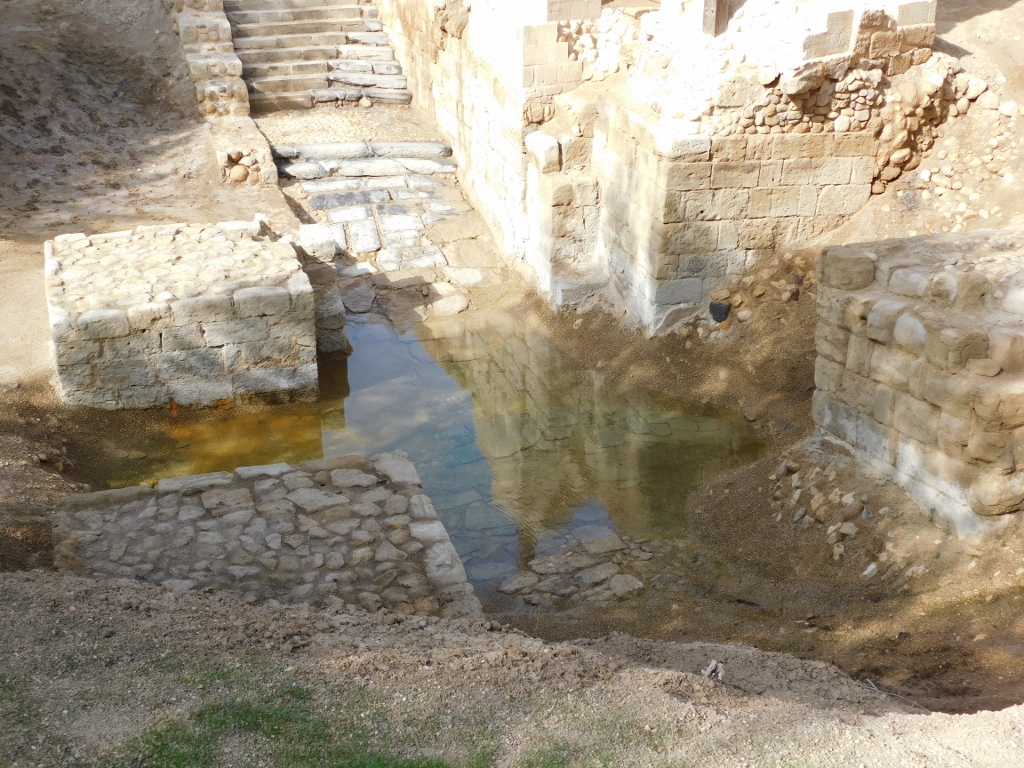 Baptism Site “Bethany Beyond the Jordan,” the baptismal pool
Baptism Site “Bethany Beyond the Jordan,” the baptismal pool
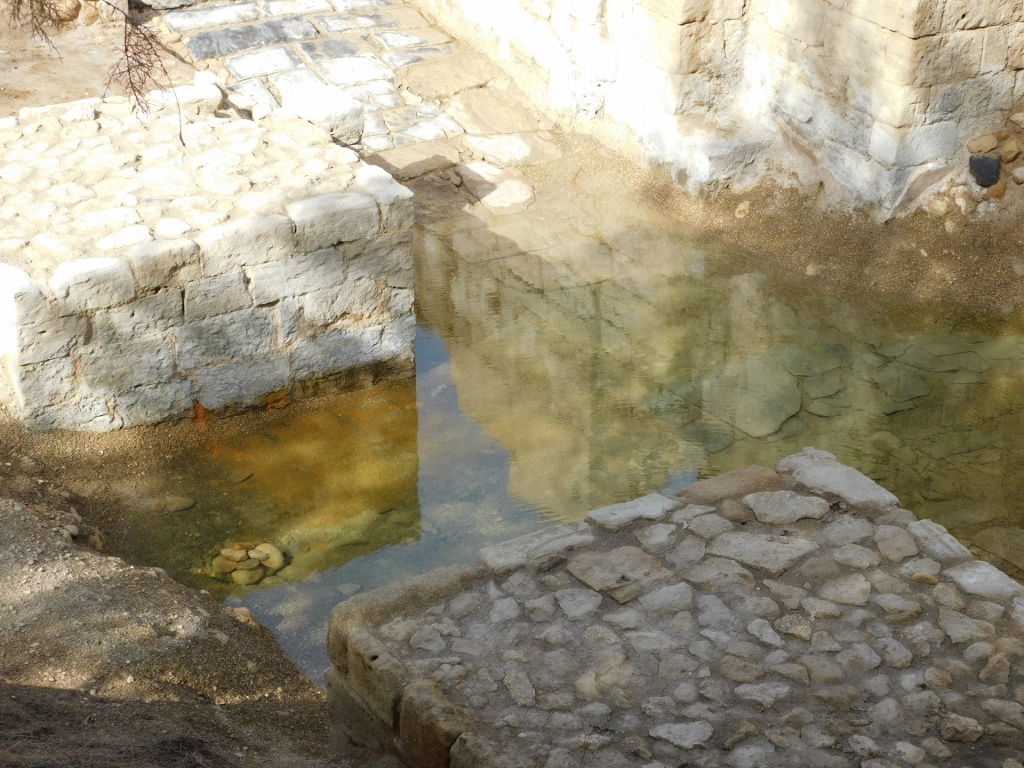 Baptism Site “Bethany Beyond the Jordan,” the square-base baptismal pool
Baptism Site “Bethany Beyond the Jordan,” the square-base baptismal pool
When the Mantle Chapel carried by the four arches perished, a small chapel with an apse was built over the remains of the northwest stone pier. There are records about it as well, from the beginning of the 12th century, and today its remains have been canopied in order to protect them.
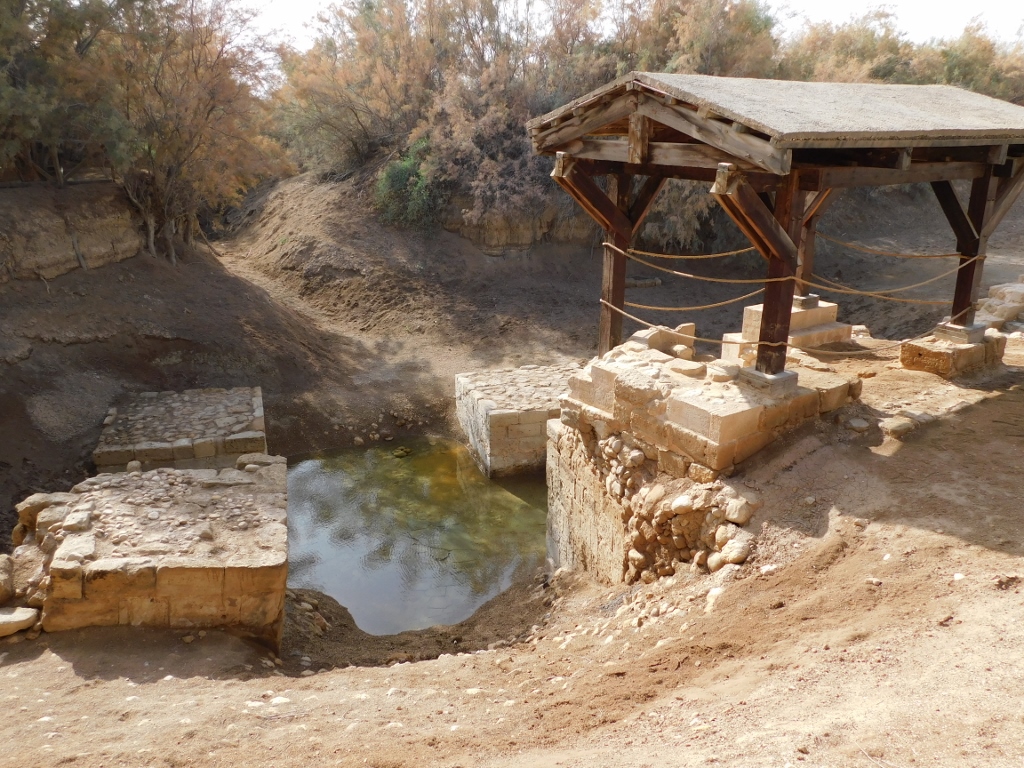 Baptism Site “Bethany Beyond the Jordan,” the baptismal pool
Baptism Site “Bethany Beyond the Jordan,” the baptismal pool
So, all the records suggest that this was precisely the place where Saint John baptised Jesus Christ. Even if this were not true, the fact is that the faithful kept coming here for centuries in order to be rebaptised right here, in this place. But even if there is any doubt as to where exactly Jesus was baptised, it is known when this actually happened – on the day of Theophany, i.e., on 19 January. This feast is celebrated in Eastern Christian traditions in order to commemorate the baptism of Jesus and what followed afterwards. According to the Bible, Jesus prayed after his baptism (note that irrespective of the proximity of the dates, all of this did not happen right after the birth of Jesus, but when he was around 30) and then the sky opened “and the Holy Spirit descended on him in bodily form like a dove. And a voice came from heaven: “You are my Son, whom I love; with you I am well pleased.” (Luke 3:22). This is not a common occurrence within the Christianity. Not at all. Namely, according to the tradition, this is the only place where the Holy Trinity was at the same place and at the same time: God the Father (as the voice), the Son – Jesus Christ (in bodily form) and the Holy Spirit (as the dove).
Because of the magnitude of this significance, although this archaeological site was found only some 30 years ago, it is already in the UNESCO’s World Heritage List.
After a short stay near the baptismal pool, we also went to the place where the remains of the churches have been found.
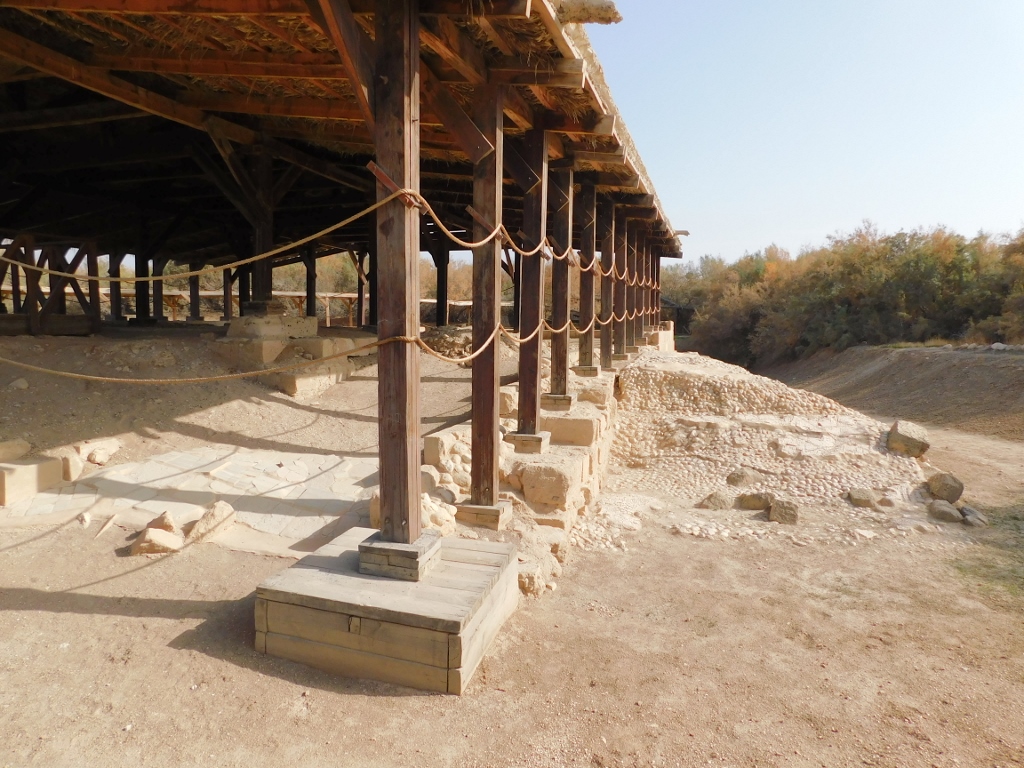 Baptism Site “Bethany Beyond the Jordan,” remains of the churches
Baptism Site “Bethany Beyond the Jordan,” remains of the churches
In the photo above, on the right-hand side, it is possible to see modest remains of a mosaic (uncovered). But, perhaps even more important is the fact that a part of the floor covered in marble slabs can be seen on the left-hand side. The researchers have established that the marble had been brought from Italy. And it is precisely this detail that corroborates the significance of this venue or at least the importance given to it by the builders some millennium and a half ago. Namely, there is not a single place around this area where marble can be quarried – the construction usually uses local sandstone or possibly limestone. In other words, it was necessary to bring large quantities of marble from afar and this would certainly not be done for an “ordinary” church.
Continuing with our sightseeing tour, a few hundred metres farther, we got to the Church of St. John the Baptist that belongs to the Greek Orthodox Church.
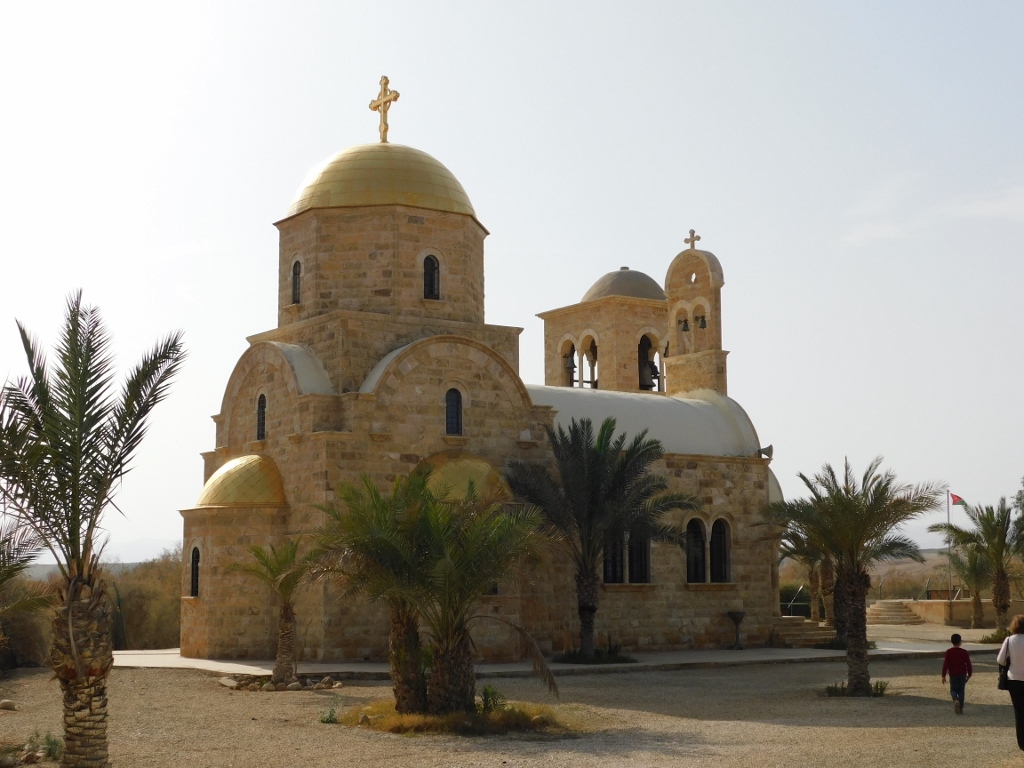 Church of St. John the Baptist
Church of St. John the Baptist
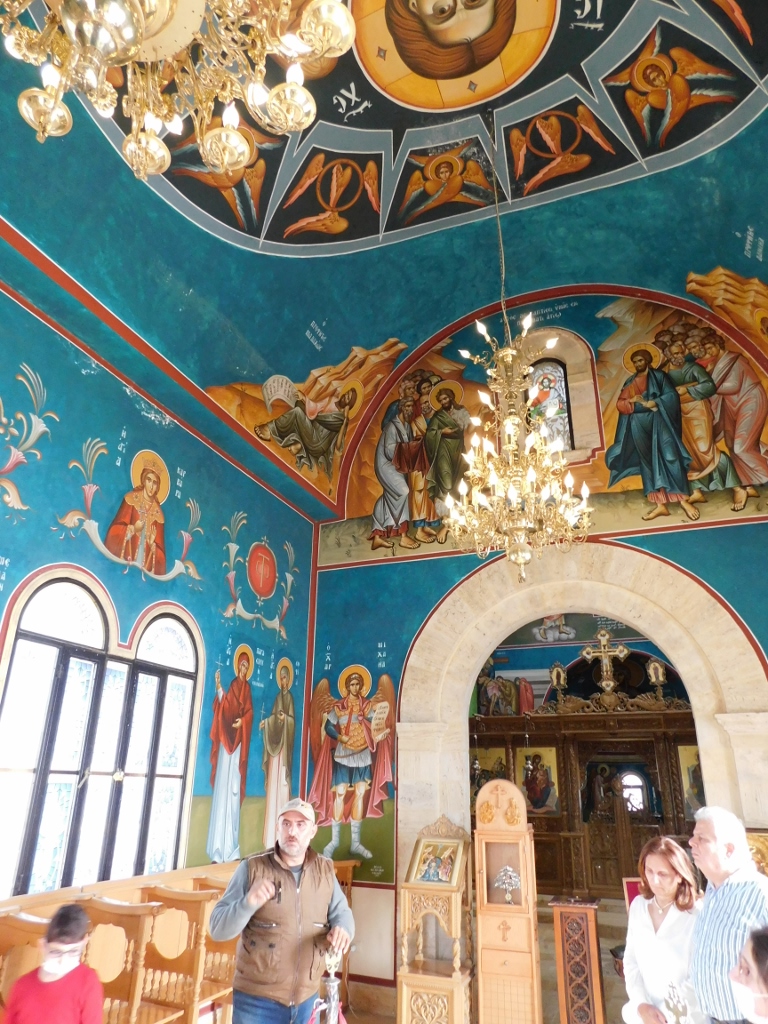 Church of St. John the Baptist, details from the interior
Church of St. John the Baptist, details from the interior
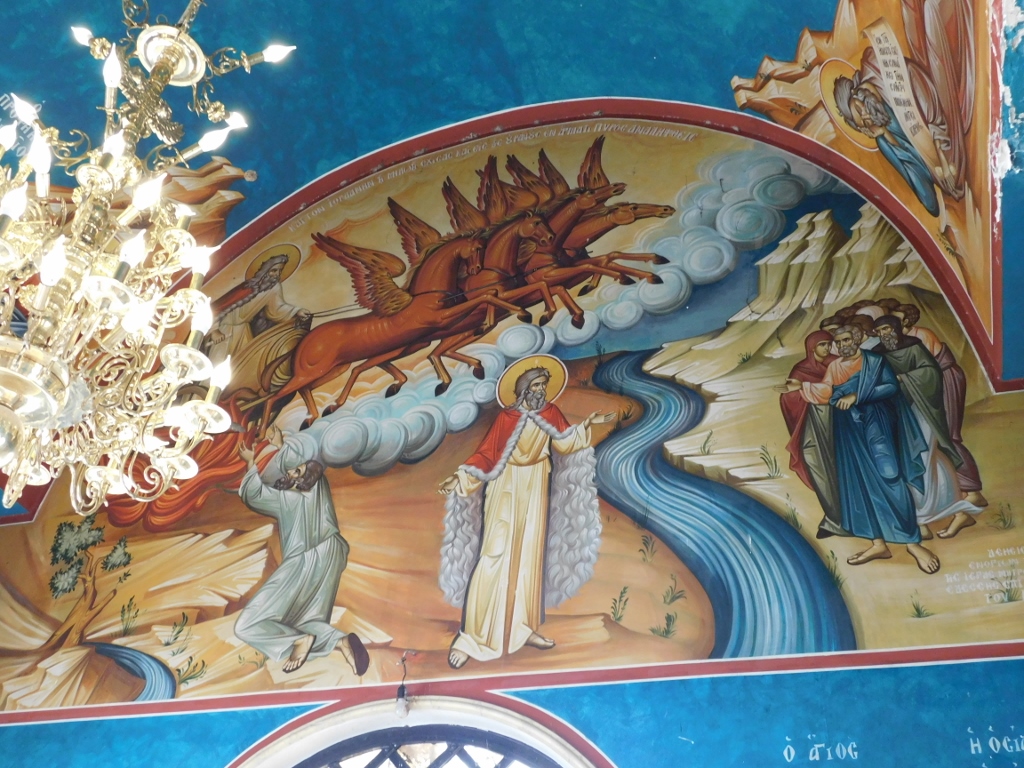 Church of St. John the Baptist, details from the interior
Church of St. John the Baptist, details from the interior
Still, this church serves all, not only the Greeks, and anybody who wants to come here to be baptised may do so using the water from the Jordan river. It is also possible to do this by direct immersing in the Jordan. The place for this is situated practically in the continuation from the plateau in front of the church.
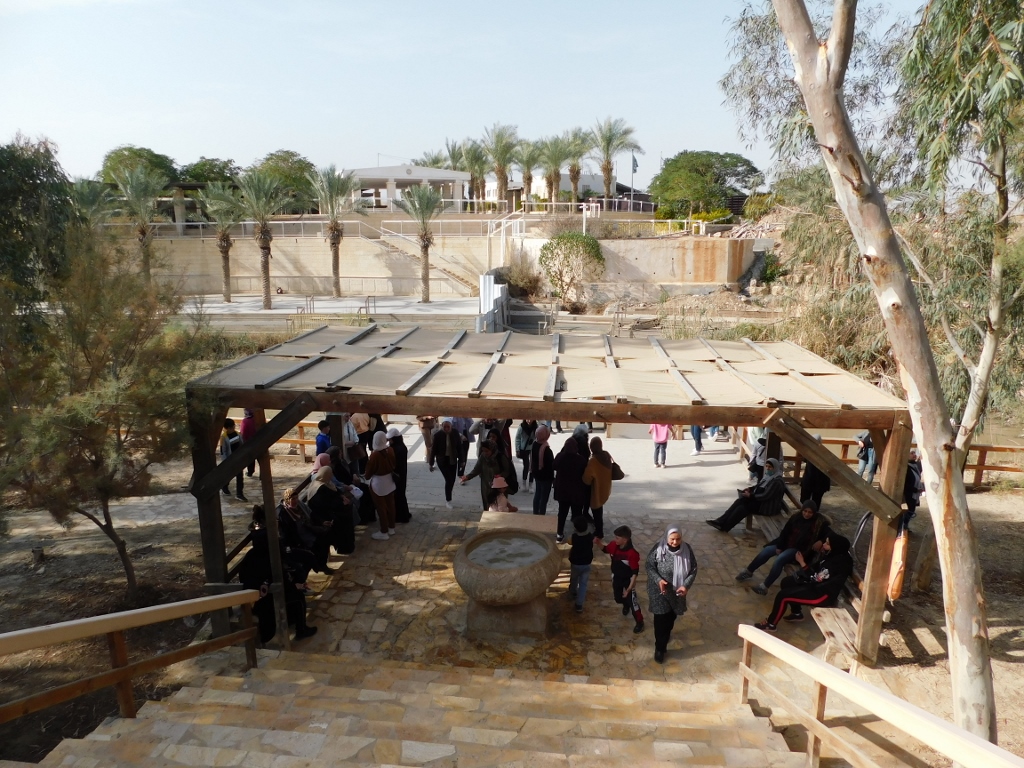 Baptism Site “Bethany Beyond the Jordan,” the staircase and access to the Jordan river
Baptism Site “Bethany Beyond the Jordan,” the staircase and access to the Jordan river
If you look at the photo above a little better, you can notice on the right the Jordan river which is not seen in the middle part of the photo because of the canopy. but, when you get to the river, the whole situation is seen much better. The buildings, both those finished and those in the making, on the other side of the river are a part of the Qasr al-Yahud site located on the territory of Palestine occupied by Israel since 1967.
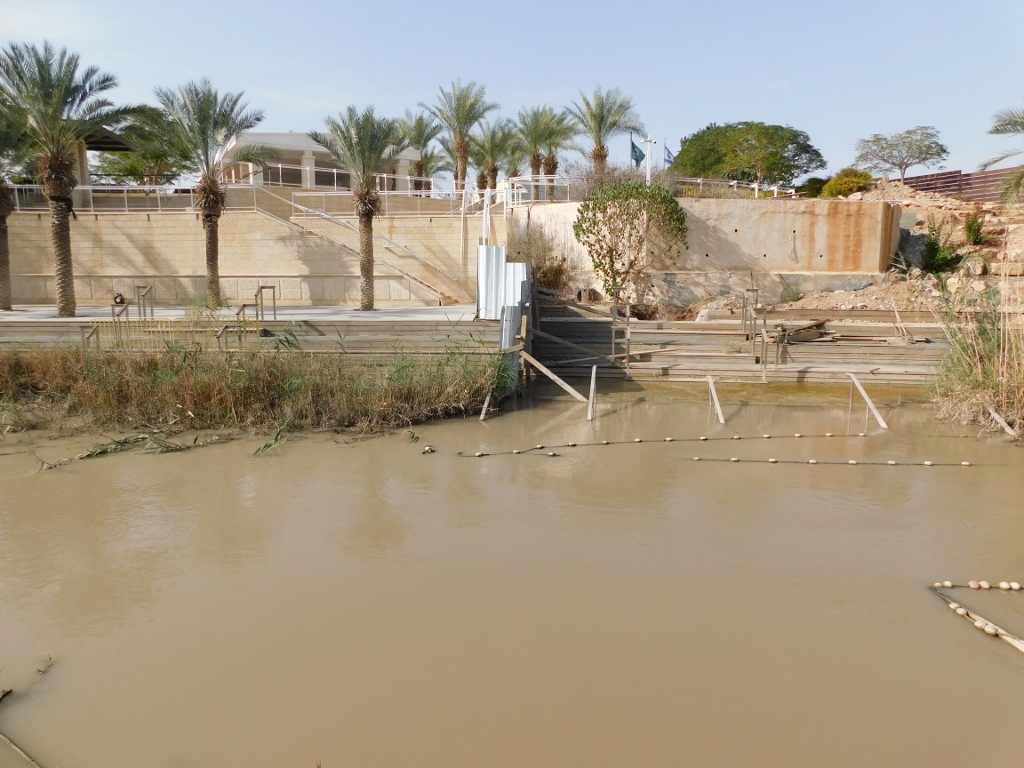 Qasr al-Yahud
Qasr al-Yahud
As it may be seen, the West Bank, i.e., Palestine, i.e., Israel, is almost incredibly close here and some Jordanian members of the group with which I visited the site, who spoke English, told me with great sorrow, as well as bitterness in their voices that this was their land. Irrespective of who this land belongs to, it is a fact that the site linked to the baptism of Jesus on the other side of the Jordan is managed by the Israeli state. I have already mentioned that the access to the Jordan river was easier in the past as well and back then the renewed baptisms were carried out on the other bank. However, perhaps precisely because of this and in a way because of the competition for tourists and pilgrims, the Jordanian side insists that the proper baptism site was in “Bethany beyond the Jordan”. I must admit I fully agree with them.
Whoever wants to be baptised in the Jordan river, on either side, must be ready to enter the visually rather unattractive waters of the river, but the logistical support is in place.
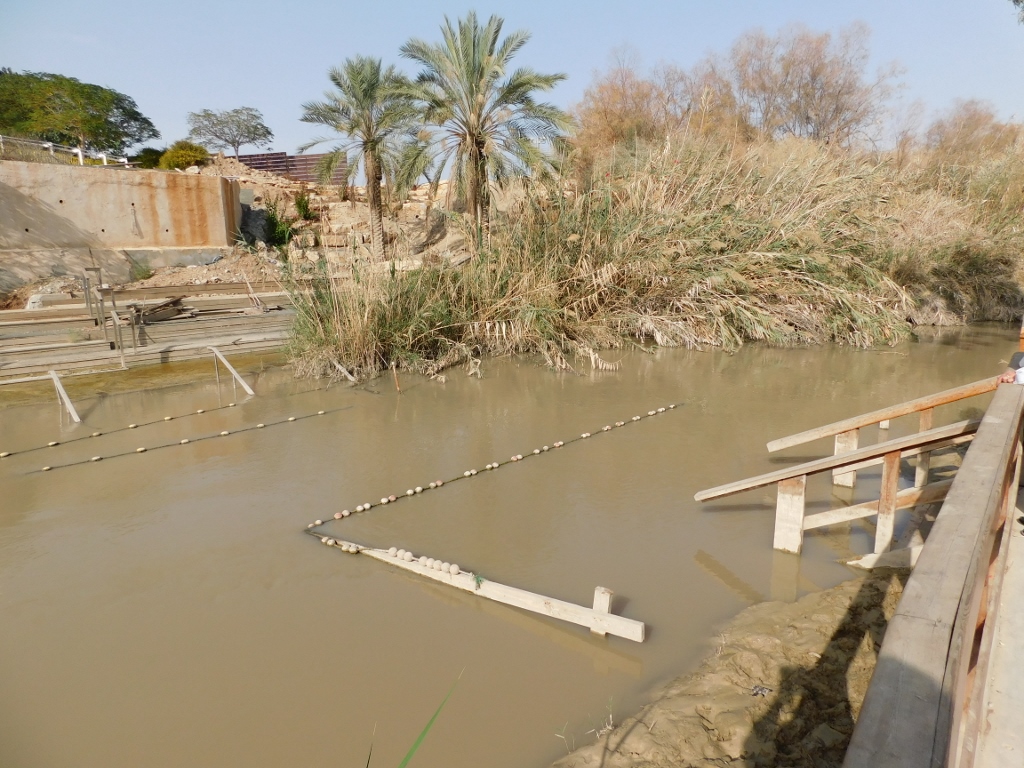 Places for baptisms in the Jordan river
Places for baptisms in the Jordan river
Needless to say, I felt no need to get baptised and even less to enter the water, but I could not help myself and had to dip in my hand. I’m glad I had my face mask on – this will be a nice reminder of the situation as it was at the beginning of 2022.
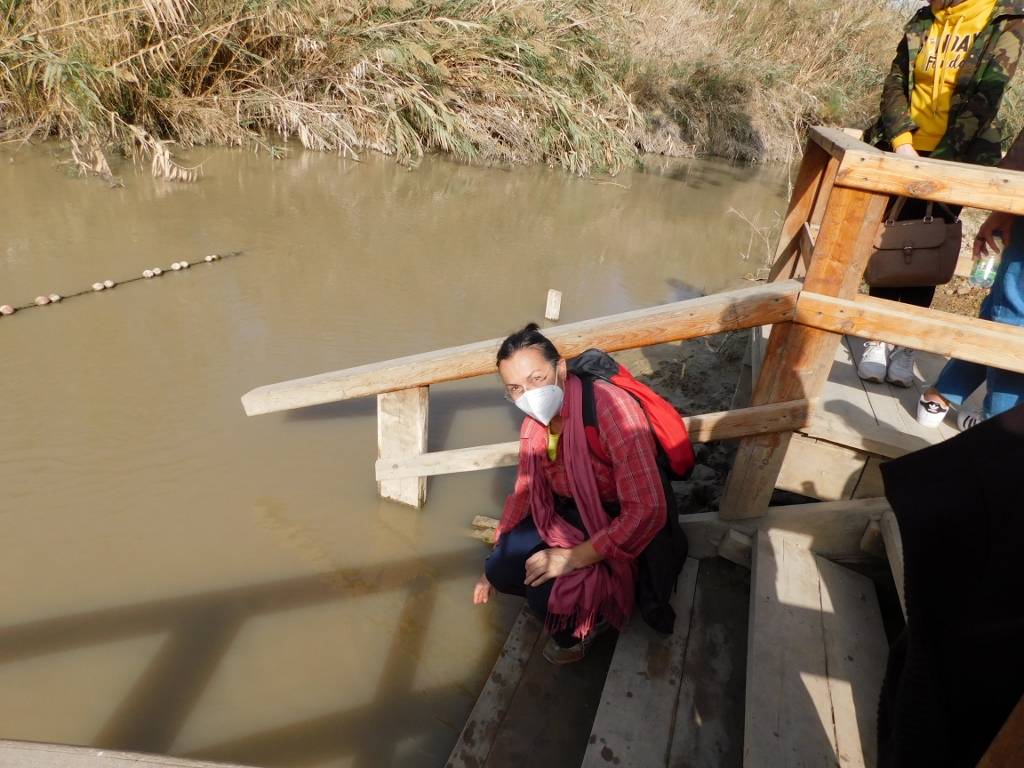 No baptising, but there is dipping in of my hand
No baptising, but there is dipping in of my hand
Here I started to communicate more with a very nice couple from Amman and this showed that being a part of a mixed group, with visitors from Jordan, had its significant advantage – namely, first they offered to me some cookies and afterwards I wrote down the names for some of them. I also got a recommendation for an exceptionally and incredibly popular local dessert, as well as information about where I can find it in Amman. But, more about this later on.
For now, we continued with our walk around the site and so we crossed a bridge over a stream that a few dozen metres later joined the Jordan.
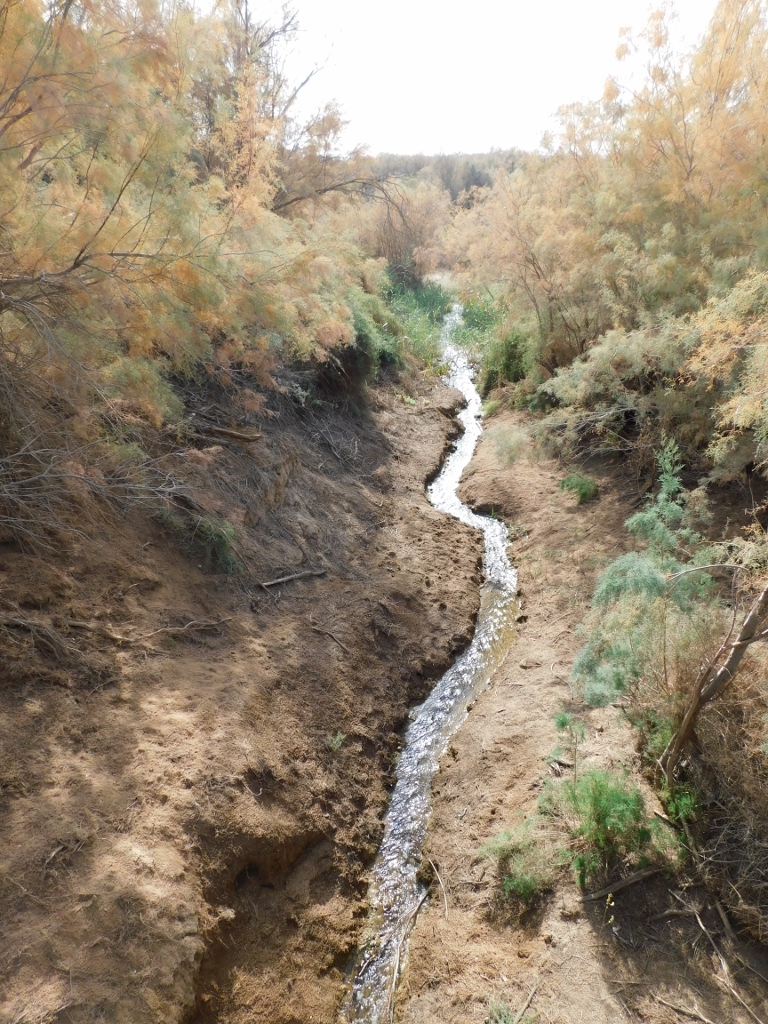 The Wadi al-Kharrar brook
The Wadi al-Kharrar brook
We also stopped at the Baptismal Site Museum that belongs to the Greek Orthodox Patriarchate, as well as a souvenir shop, and then we returned to the mini-bus that took us back to the visitor parking lot. I parted cordially from the kind couple from Amman, as well as from the very good and exceptionally well-read guide. Then I got into the comfortable hybrid car that I rented together with the driver for this trip and we continued with our tour. The next destination was the city of As-Salt which everybody calls simply – Salt.
But, I found it interesting that we drove up along a winding road that leads through one of the many gorges in Jordan. I have already mentioned that the Baptismal Site is at the elevation of -350 m (MINUS!!!), with As-Salt being at around 900 m a.s.l., while the distance is less than 40 km. I was learning about the topographic features of this part of Jordan from the comfort of the car. Above the fertile and green valley through which a river flows, first I saw bare slopes of the gorge, but later on significant quantity of greenery appeared on the slopes, as well.
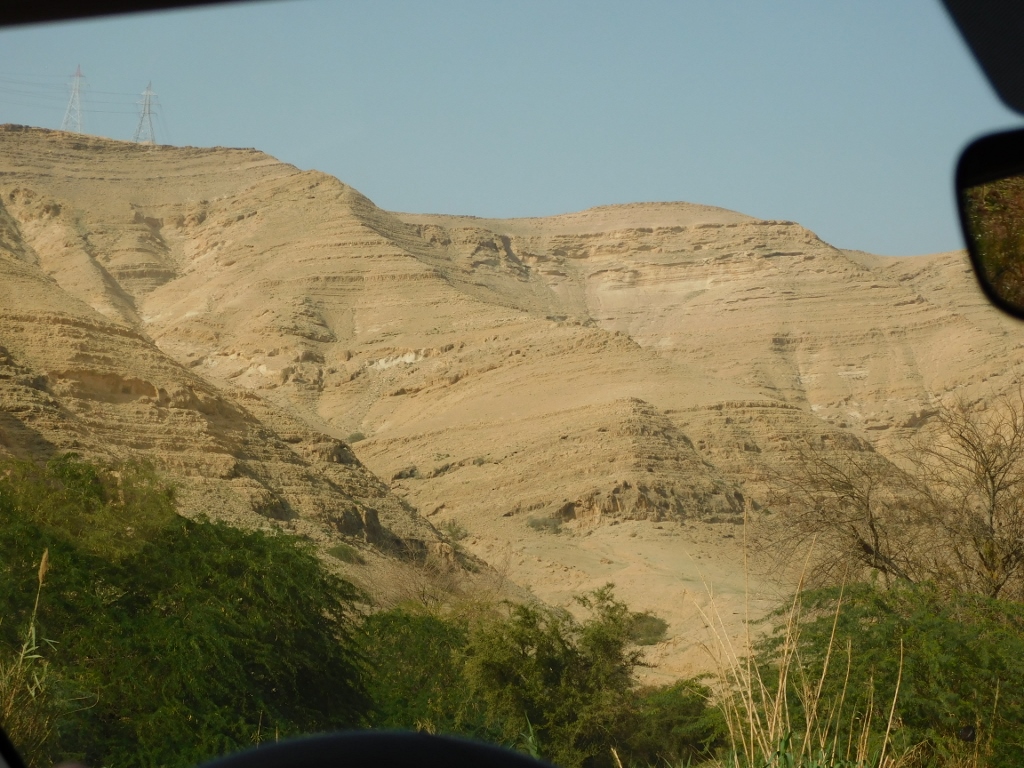 Sight from Wadi Shueib
Sight from Wadi Shueib
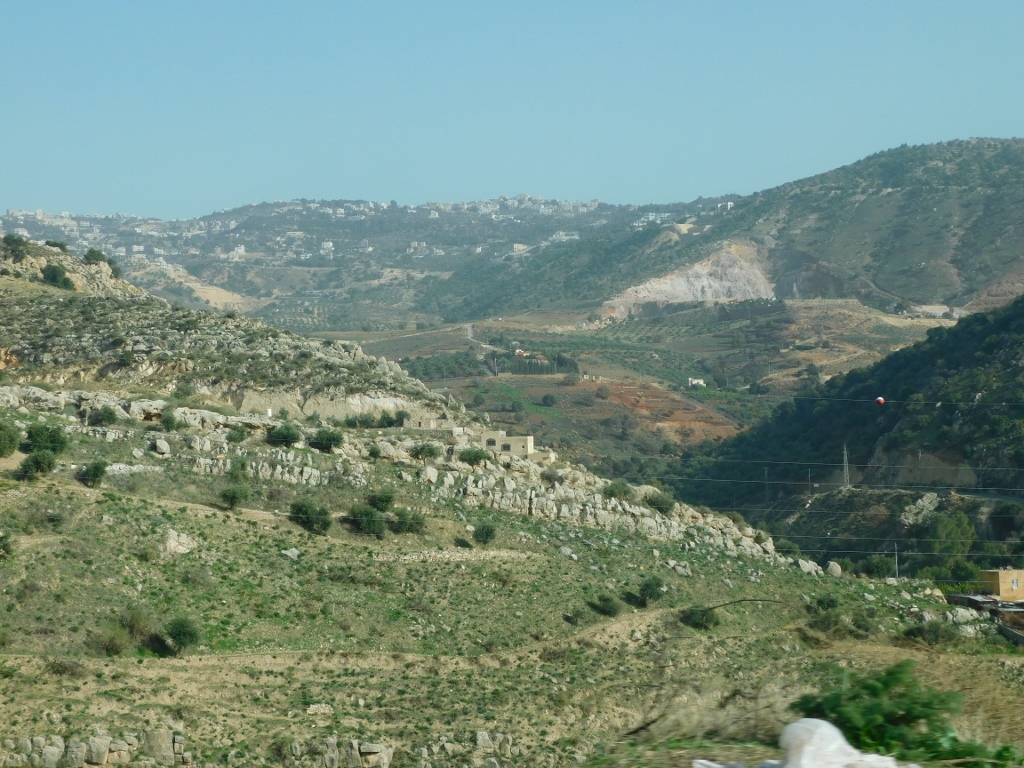 Sight from Wadi Shueib
Sight from Wadi Shueib
As for As-Salt, it is a city that in the past used to be an important trading link between the desert in the east and the west regions. In the second half of the 19th century, while the city as the regional centre was under the Ottoman rule, the trade developed even further and because of the enrichment of the merchants who moved here from other parts of the empire there was also development of architecture and crafts. Thus, a modest rural settlement started to develop and get large public buildings and family mansions made of local honey-coloured limestone. It all somehow came to an end with the disappearance of the Ottoman Empire from the world scene around 1920 and the transfer of the capital to Amman which happened soon after. Today, this city boasts almost 650 important historical buildings made in different European architectural styles, but visiting all of them would require a lot of time which I certainly did not have, plus it would surpass the level of my knowledge of this field and even my interests. To start with, we parked near the Salt Archaeological Museum that uses one of the buildings from the Ottoman period.
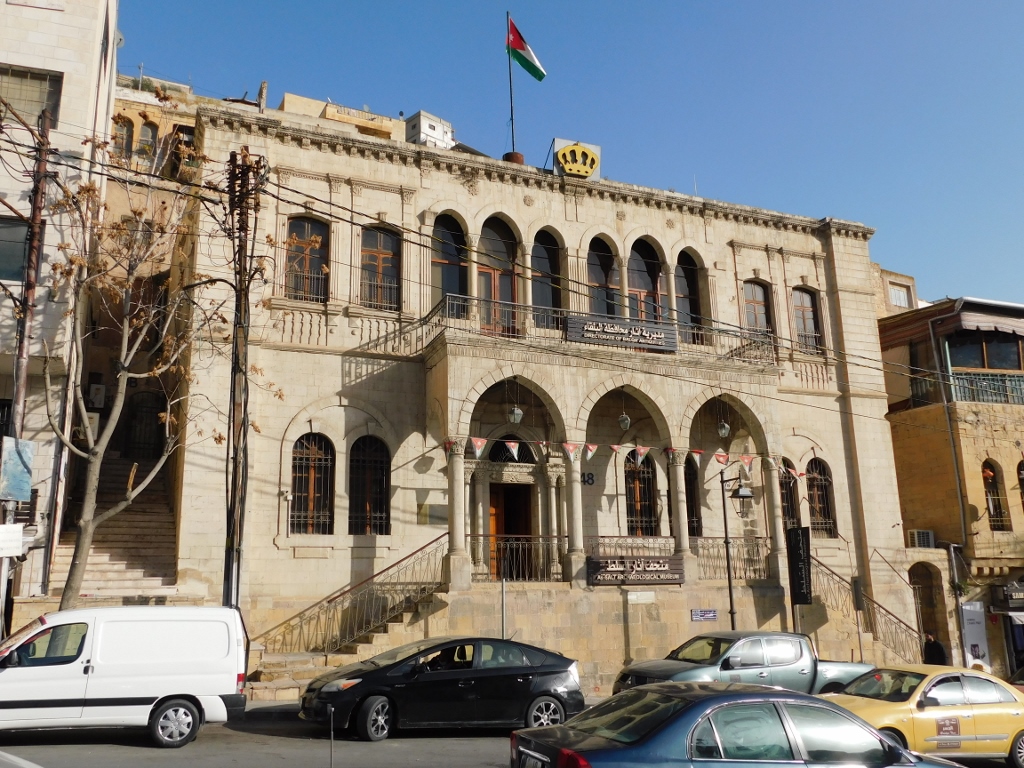 Salt Archaeological Museum
Salt Archaeological Museum
Although I saw a large visitor centre here, it was closed. On the other hand I did not have a good and detailed map, the guidebooks were rather bad (I used the English-language one I bought in Amman, plus one in Italian I got at the hotel, both of them being published by well-known guidebook companies), my impression was that the important sights were poorly marked and I had limited time for the visit. Therefore, the visit to the museum was out and all I could do was to go for a quick walk around the city, finding my way around as I knew best, so I started right away. And yet, I was left with impression that this was all a pity and that this would be a very nice place for a relaxed walk and thorough sightseeing.
The centre of As-Salt is surrounded by three hills and my plan was to climb one of them. The following photo shows one of these three hills, as well as some buildings which I suppose are from the Ottoman period, but are not important enough to find their way into the guidebooks I was using.
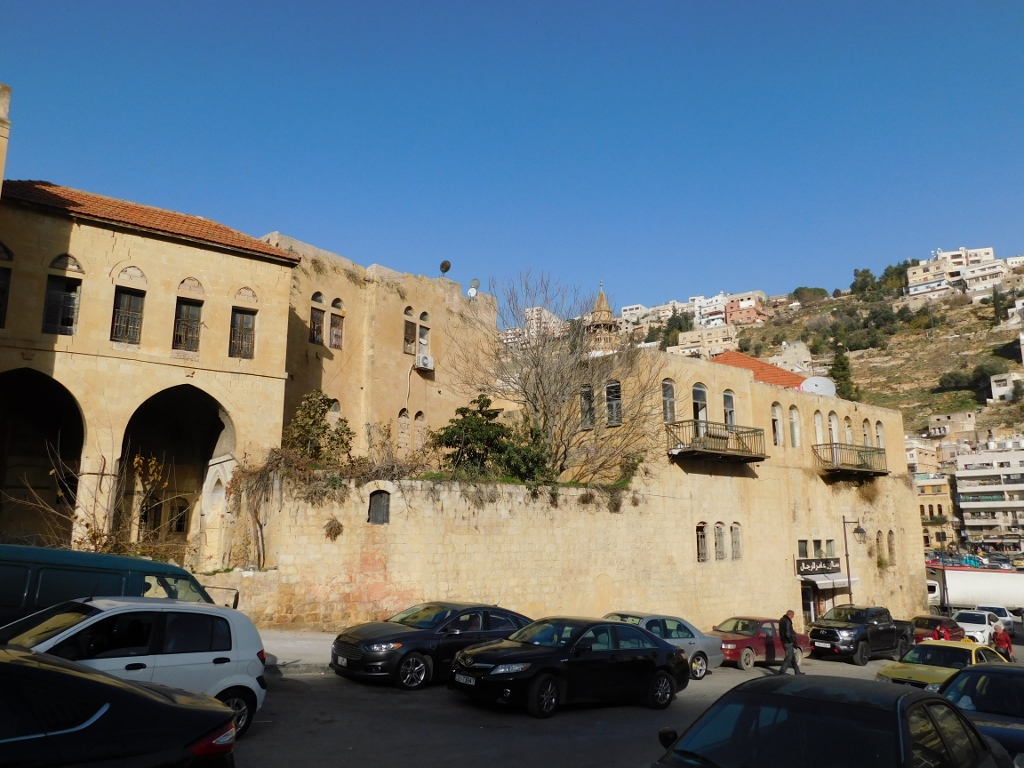 As-Salt, a detail from the centre
As-Salt, a detail from the centre
To start with, I went through a part of the souk that exists in the centre of As-Salt. Some people claim that it is the best in Jordan, but it is certainly the oldest one.
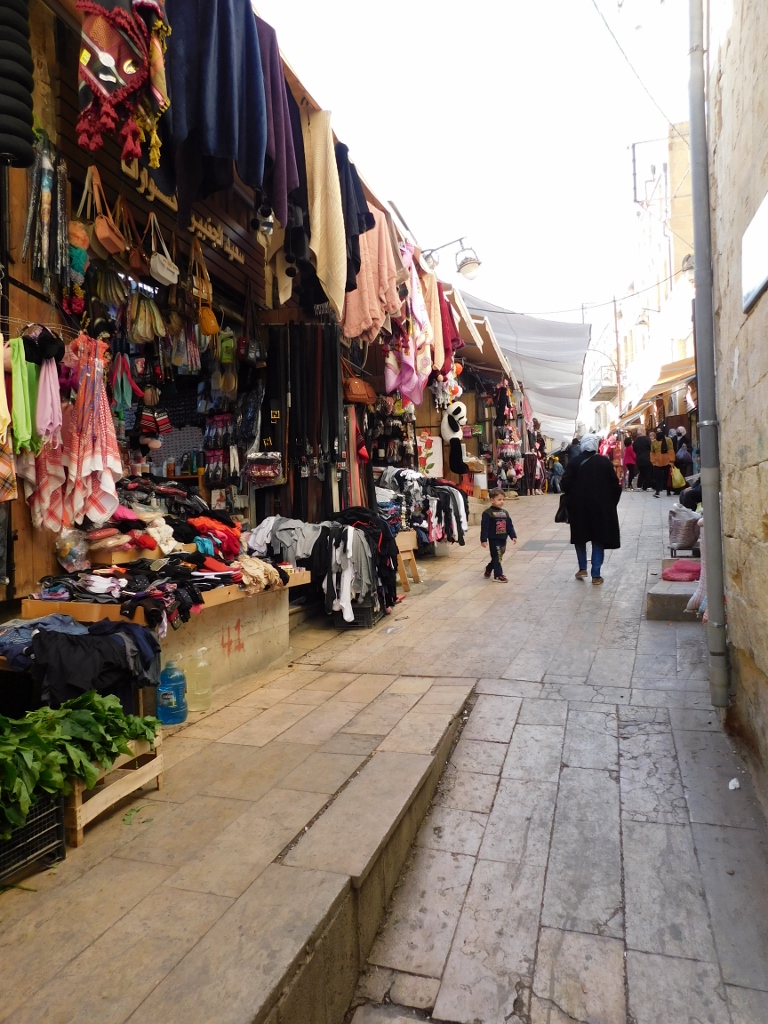 As-Salt, the souk
As-Salt, the souk
Then I continued further along the street up to Salt Grand Mosque, while on the other side of the street, on the slopes of a hill, there were numerous houses from that period when the architecture, construction and crafts flourished in As-Salt. If one has more time, there are also walking tours that lead through all these parts of the city.
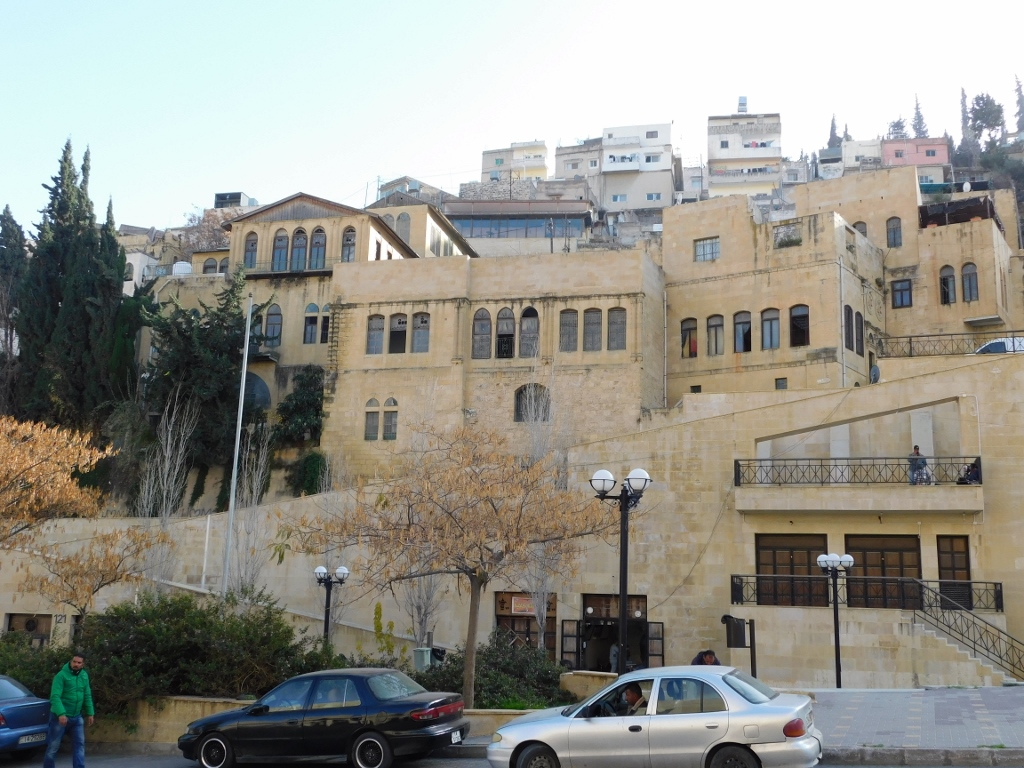 As-Salt, a detail
As-Salt, a detail
I did not have a lot of time, so I decided to face the biggest challenge first and that was climbing to Al-Qal’a hill. That involved climbing stairs. Lots of them...
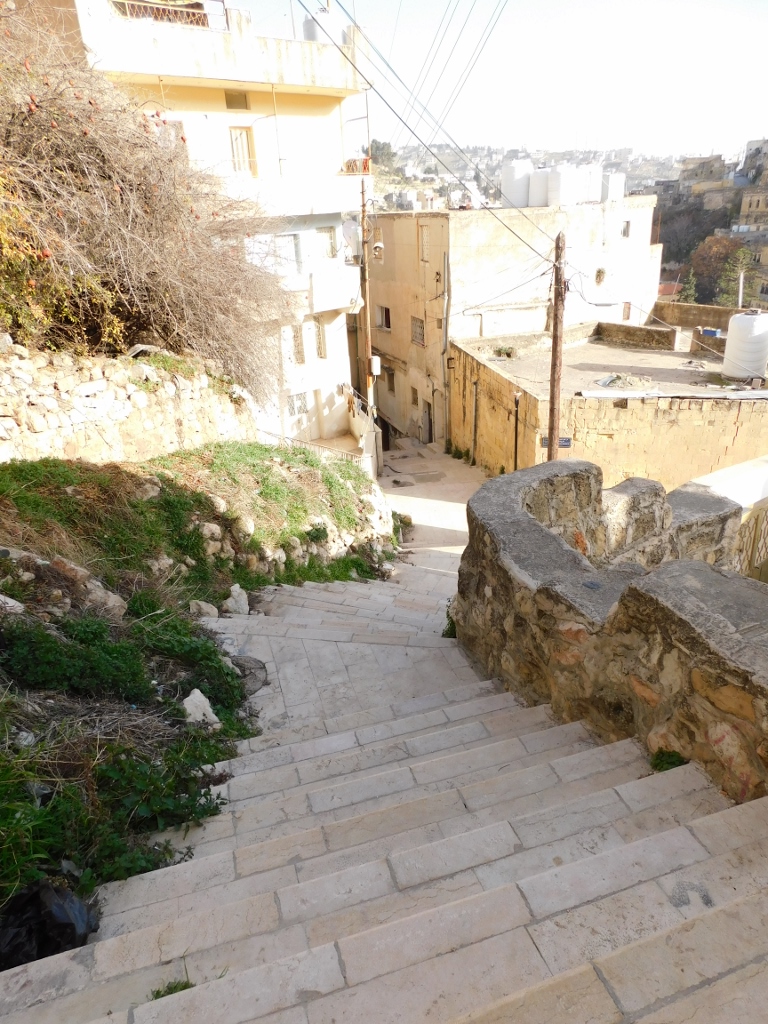 As-Salt, the stairs – I have just climbed these and now I’m catching my breath
As-Salt, the stairs – I have just climbed these and now I’m catching my breath
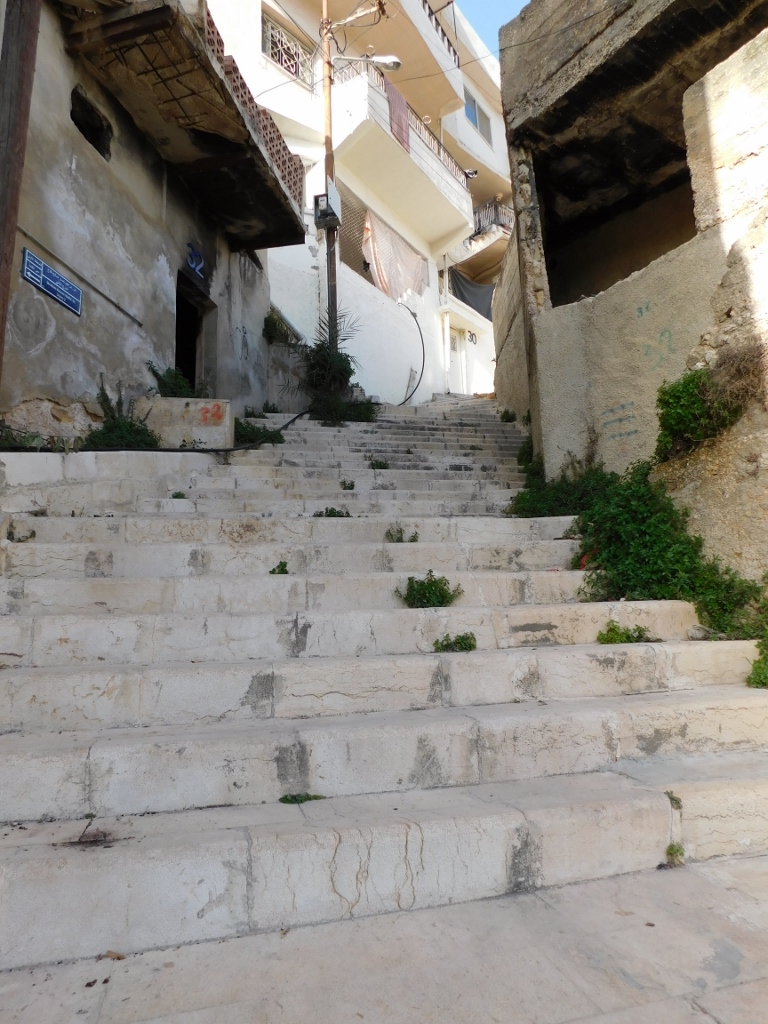 As-Salt, the stairs – I am yet to climb these, so I’m doing a silent pep talk with myself
As-Salt, the stairs – I am yet to climb these, so I’m doing a silent pep talk with myself
While climbing here, I couldn’t help but wonder what happened with the elderly and the sick here. I’m sure it is not easy living here. There is no road that leads to the house; only a myriad of steep stairways. On the other hand, those breaks that I had to make while climbing uphill were good since they gave me an opportunity to look at some details that I would probably miss out on if everything was flat. So, in one spot I noticed dried pomegranate fruits still hanging in the tree, as well as a small garden crated on the roof of a house from the lower level of buildings.
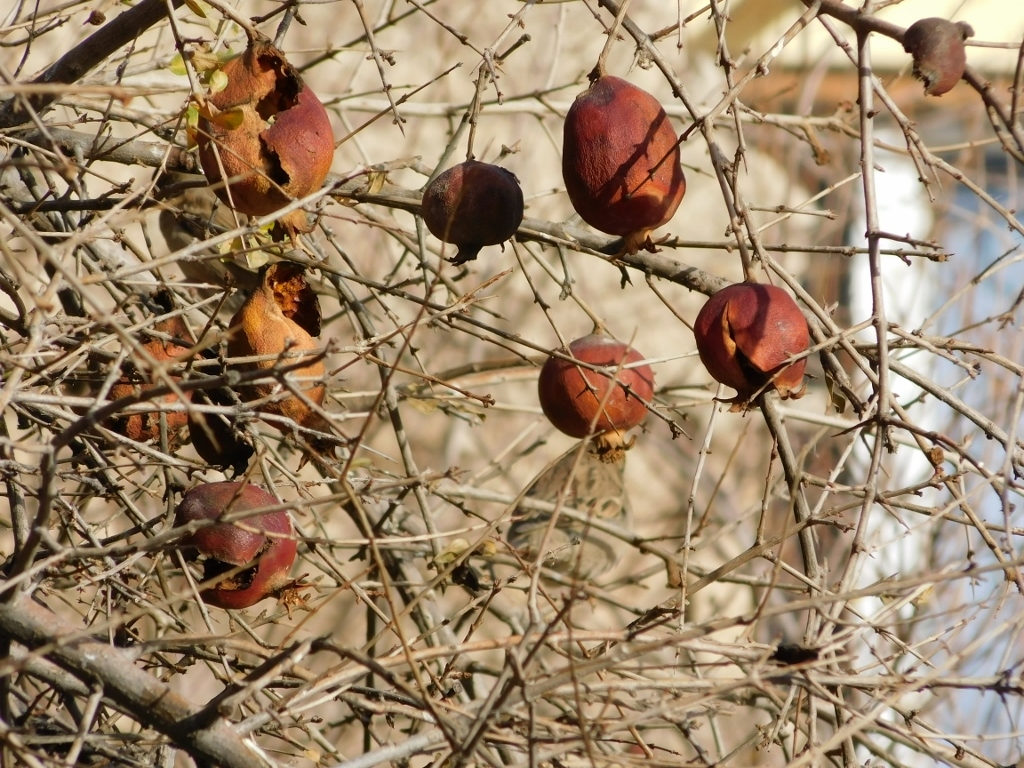 As-Salt, a detail with dried pomegranates
As-Salt, a detail with dried pomegranates
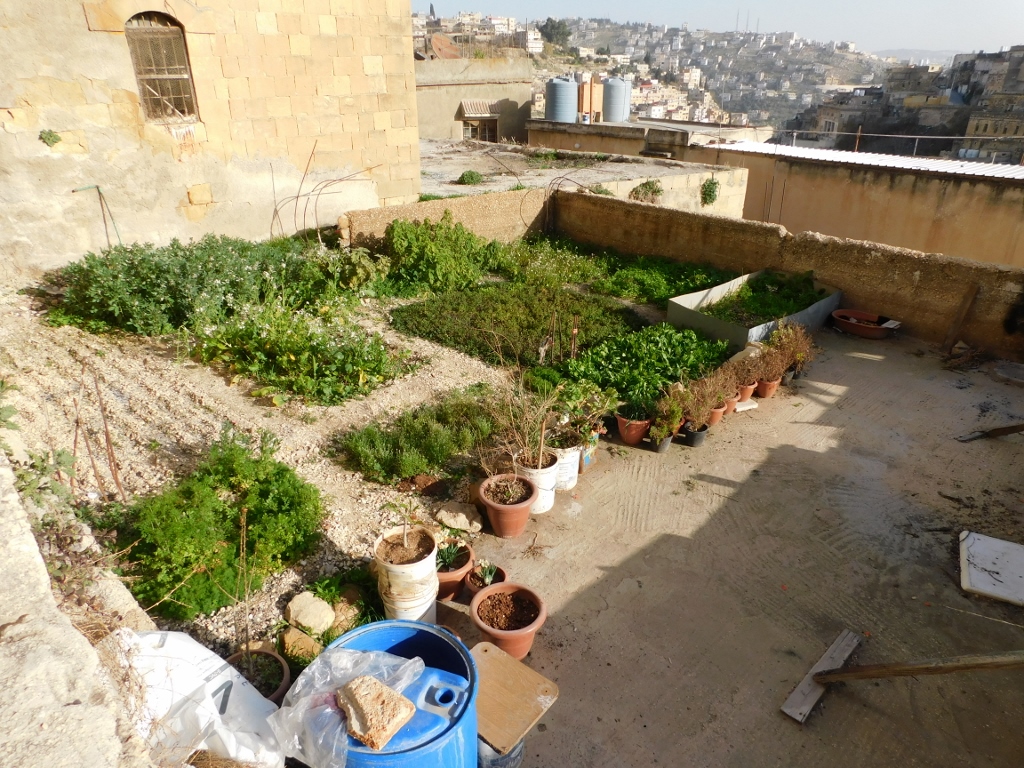 As-Salt, garden on top of a roof
As-Salt, garden on top of a roof
I also saw nicely some of the important buildings, such as the Latin Church or the Assumption of Our Lady Church.
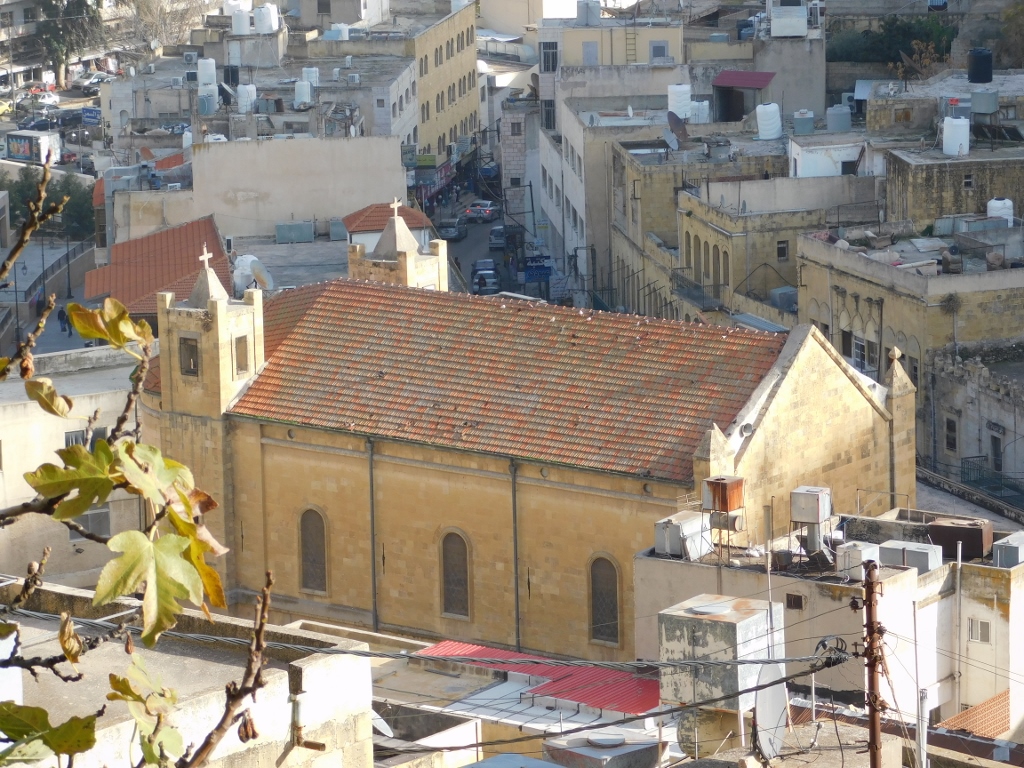 As-Salt, Latin Church
As-Salt, Latin Church
When I made my next break, in addition to the Latin Church, I could also see Abu Jaber Mansion built between 1892 and 1906 which nowadays holds the Historical Old Salt Museum.
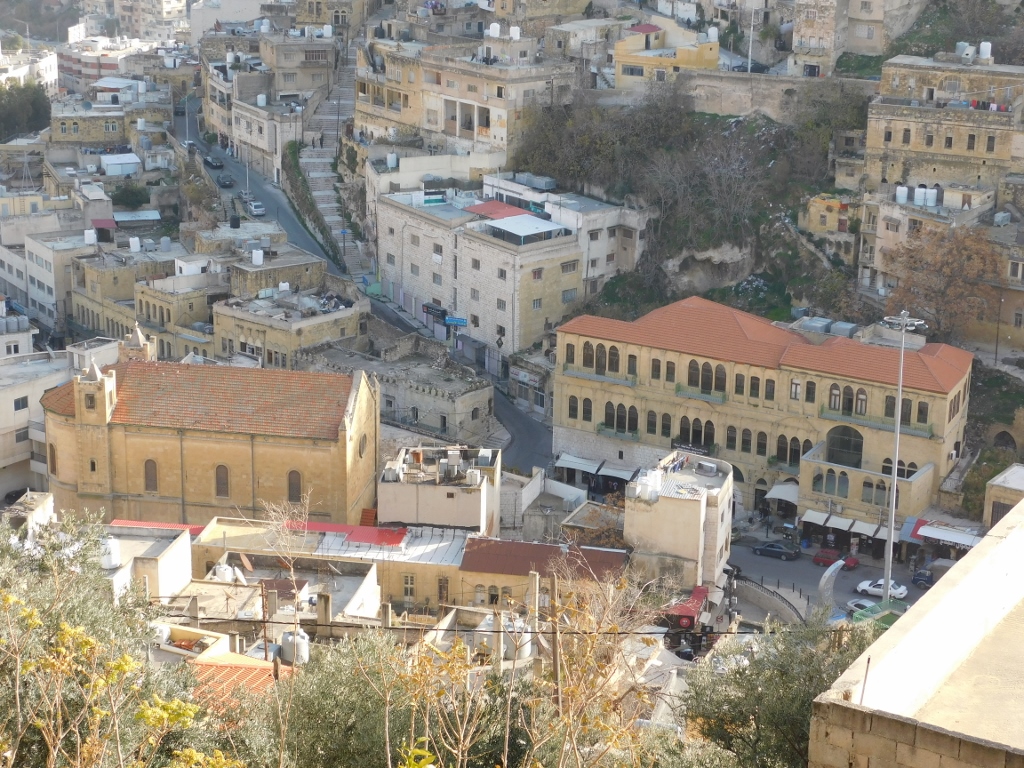 As-Salt, the Latin Church and Abu Jaber Mansion across the street
As-Salt, the Latin Church and Abu Jaber Mansion across the street
In the opposite direction, i.e., on the top of Al-Qal’a hill, I could see in front of me parts of a new mosque made in predominantly white colour.
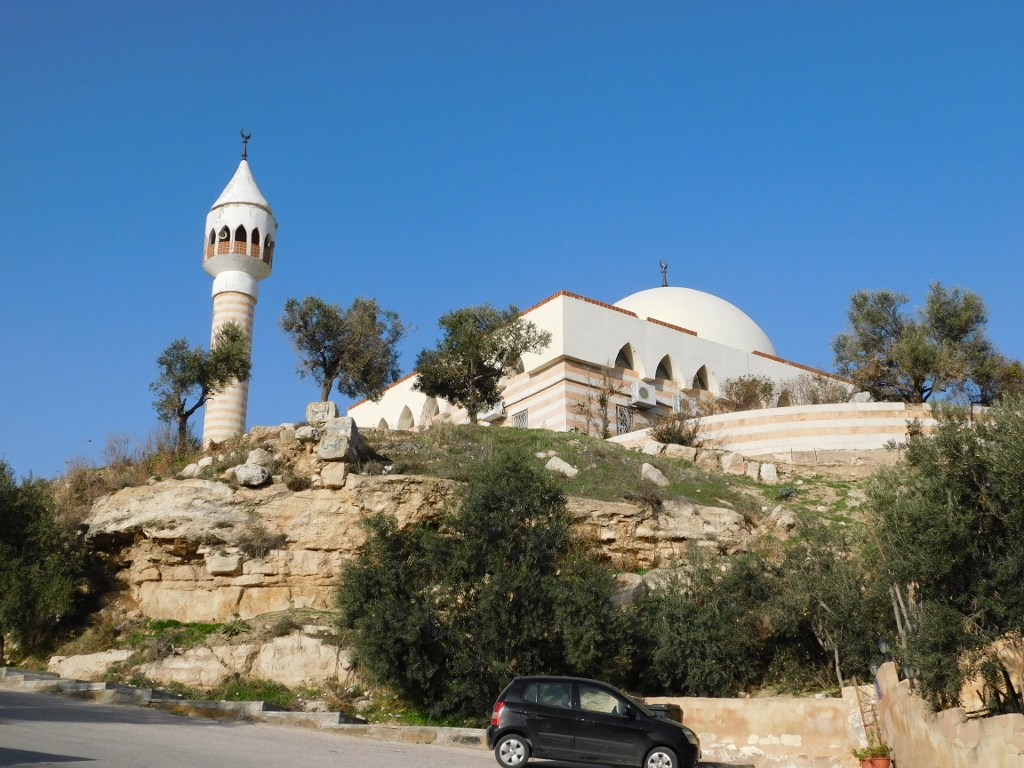 As-Salt, almost on the top of the hill
As-Salt, almost on the top of the hill
Indeed, soon I reached the very top of the hill and from there I could see remains of a fortress that used to exist here, but was demolished in the past. However, it seems that the remains have been nicely restored. According to what I have read, some other parts that were in a crumbly state were cleared in order to be able to build this new mosque on the plateau on the hilltop.
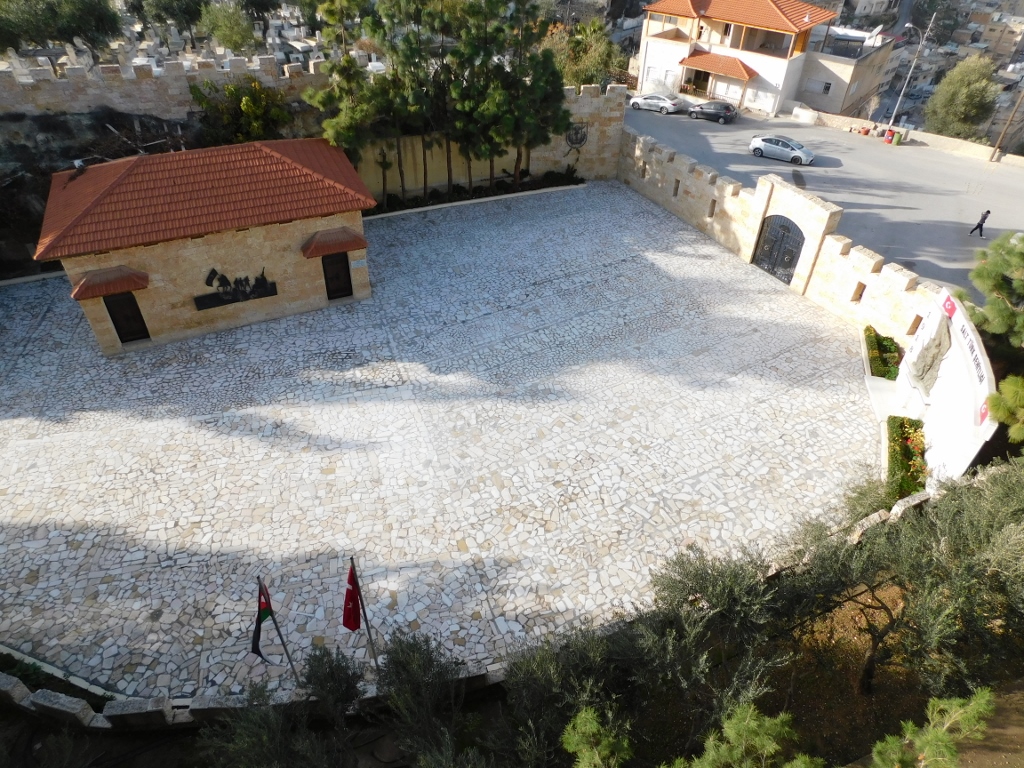 As-Salt, remains of the former fortress on Al-Qal’a hill
As-Salt, remains of the former fortress on Al-Qal’a hill
Still, the main reason why visitors are encouraged to come here is to enjoy a fine view. I particularly liked the view at the surroundings farther away from the downtown area.

I had a better view at the centre of the city when I decided to go back. The altitude difference may not be very big, but one should bear in mind that this is a very steep hill indeed and that is why I found climbing here so strenuous.
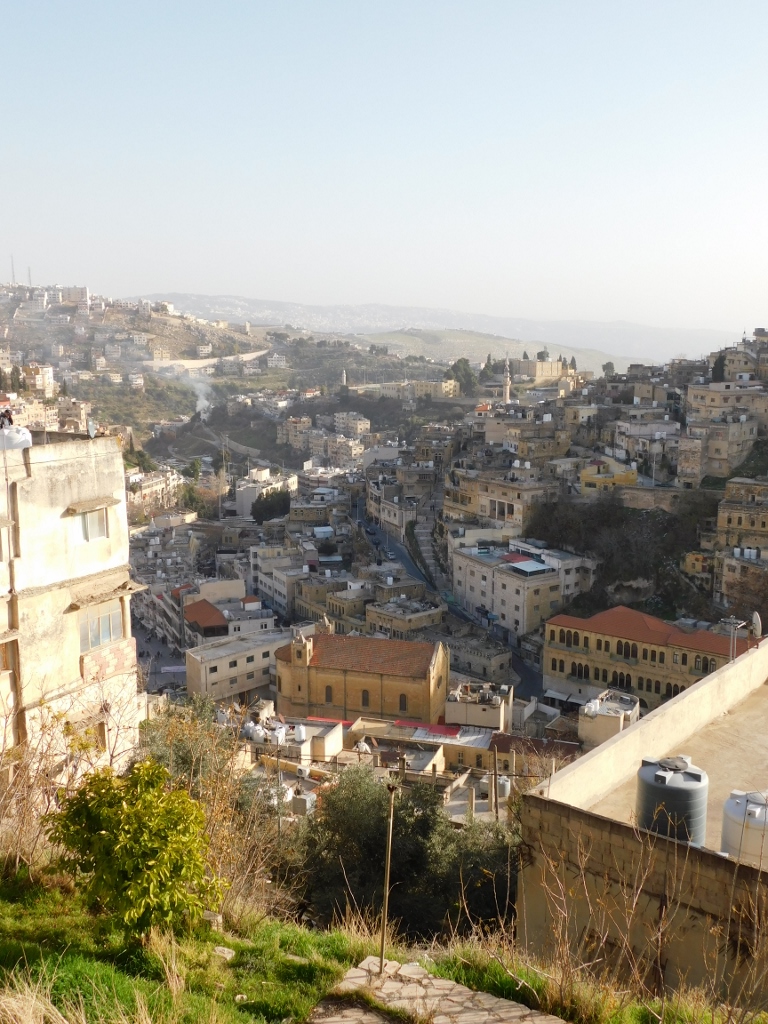 As-Salt, view at the centre of the city
As-Salt, view at the centre of the city
Of course, once you climb to the top, you’d better go down. I chose some other path, but it still involved a lot of stairs.
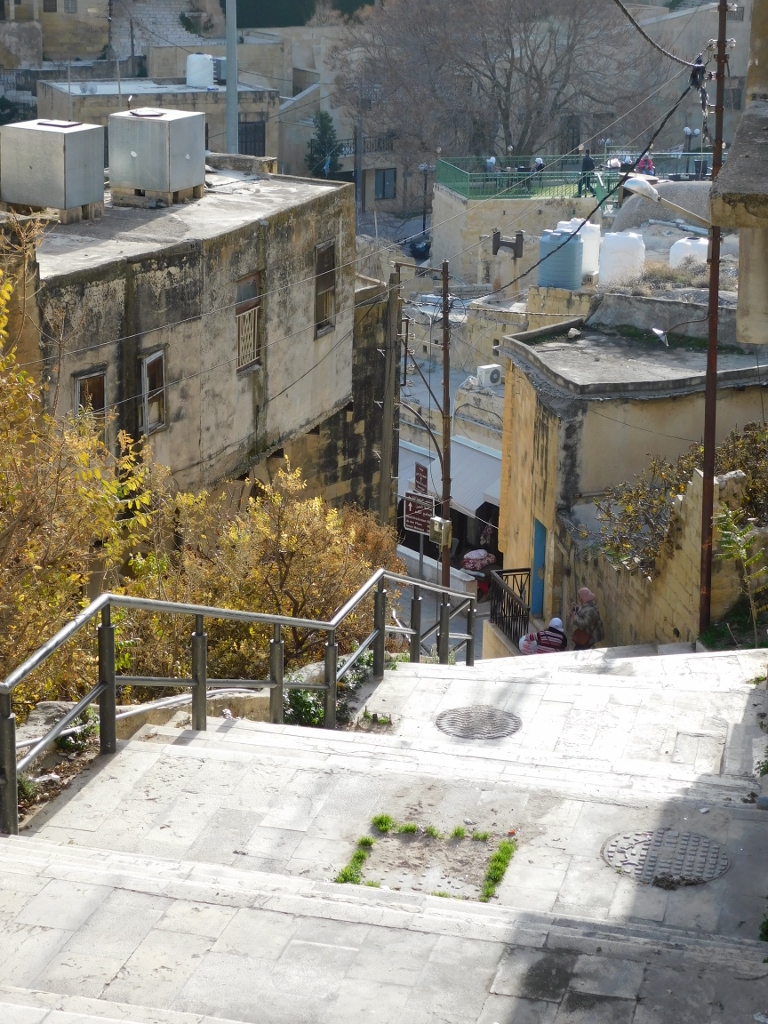 As-Salt, the stairs
As-Salt, the stairs
This time, they took me straight to the souk and from there I could see Salt Grand Mosque nicely.
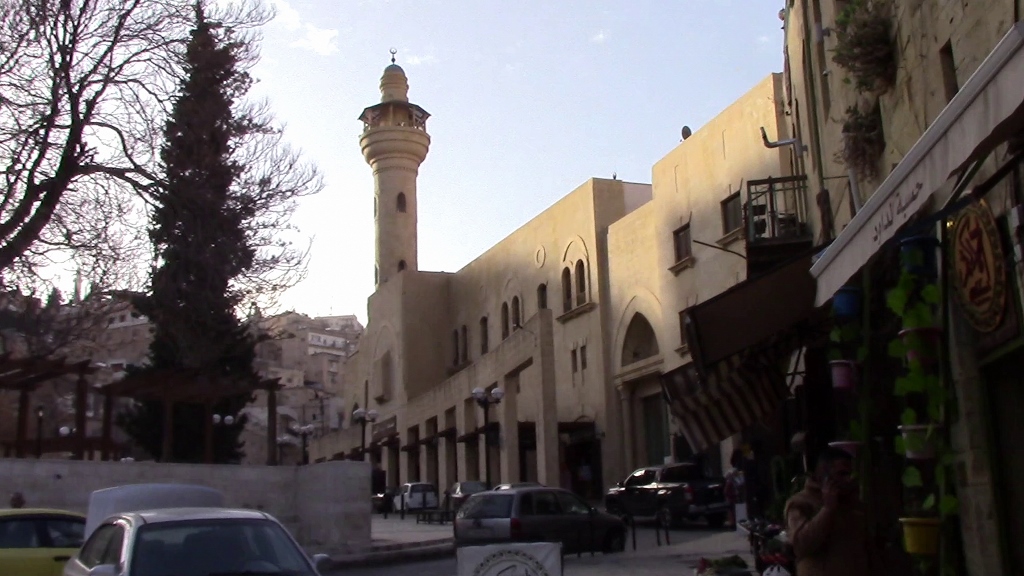 Salt Grand Mosque with a beautiful minaret
Salt Grand Mosque with a beautiful minaret
A little down the road I also passed by Abu Jaber Mansion which, as I’ve said, holds a museum. Needless to say, I did not have any time to visit it, although I had read some fine recommendations and beautiful descriptions of its interior.
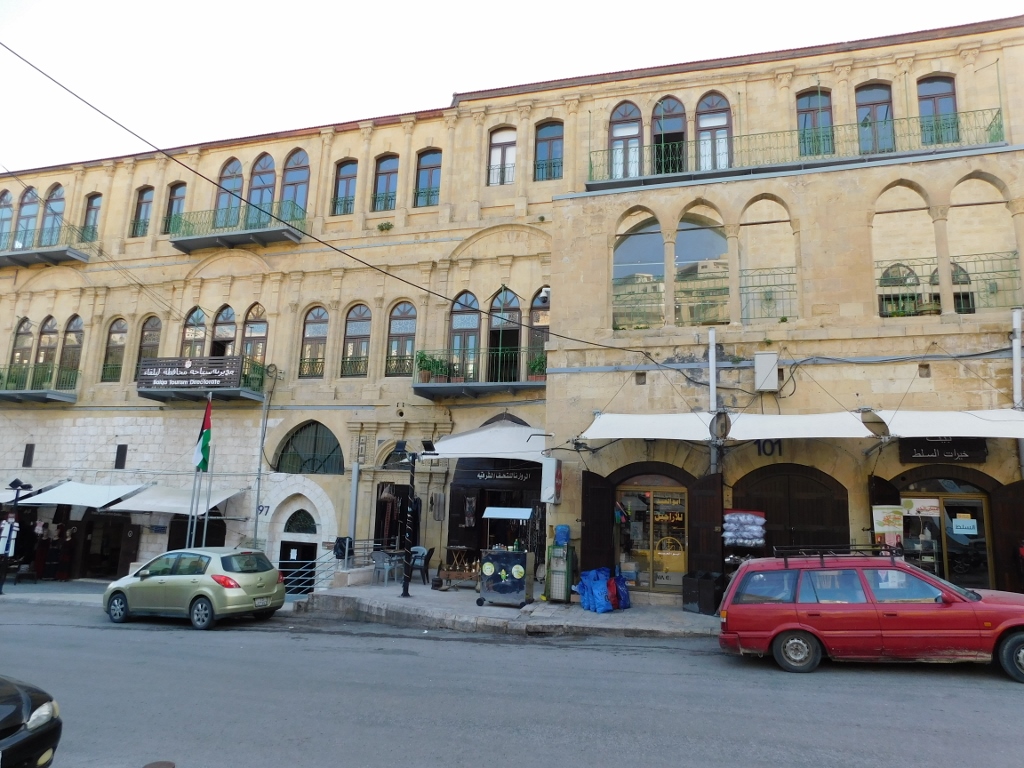 Abu Jaber Mansion
Abu Jaber Mansion
Still, in order to have as diverse idea as possible about the buildings from the Ottoman period, admittedly seen only from the outside, I walked to yet another well-known one. This was Mouasher House.
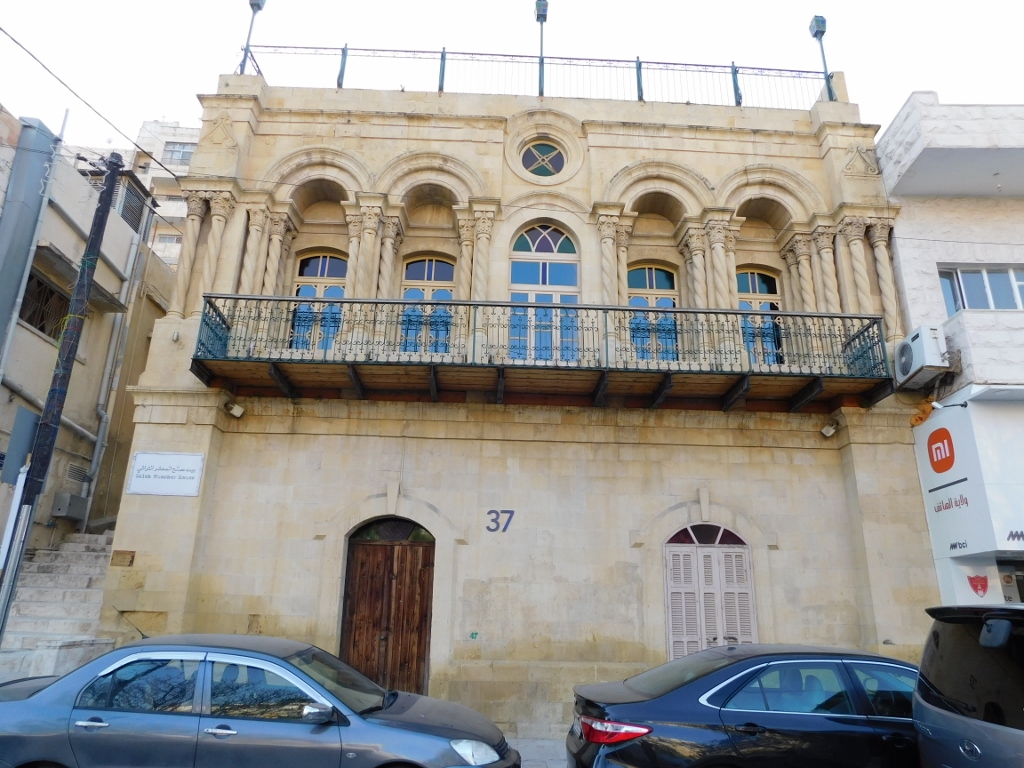 Mouasher House
Mouasher House
This is a building from the end of the 19th century that has two shops on the ground floor, while the residential area is on the upper floor. The house has been restored by the owners and turned into a private museum, with the entrance reached by an exterior staircase on the left side of the building.
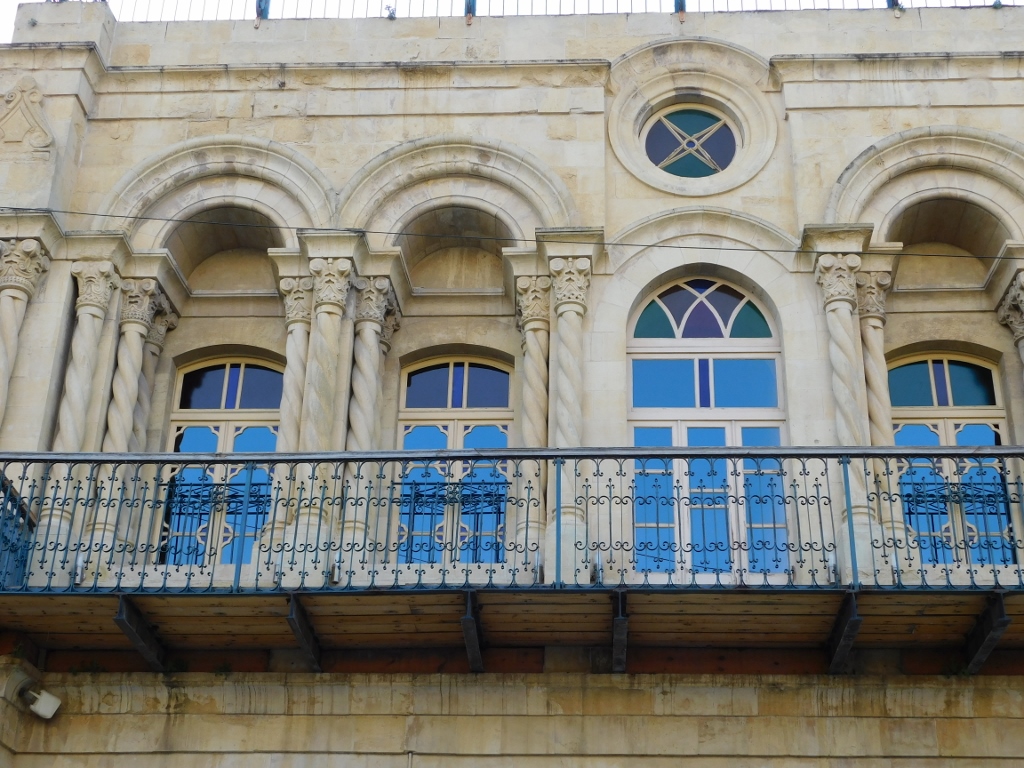 Mouasher House, a detail
Mouasher House, a detail
I practically completed my visit to As-Salt here and the only thing left to do was to walk back to the car with the driver waiting for me. I think it is a major pity that I had only an hour and a half in As-Salt. The city certainly deserves that visitors spend more time here, even if not interested in the Ottoman architecture from the turn of the 19th and the 20th centuries.
As I walked to the car I remembered – there was yet another thing I had to do here and that was to get some food. But, more about it the next time...